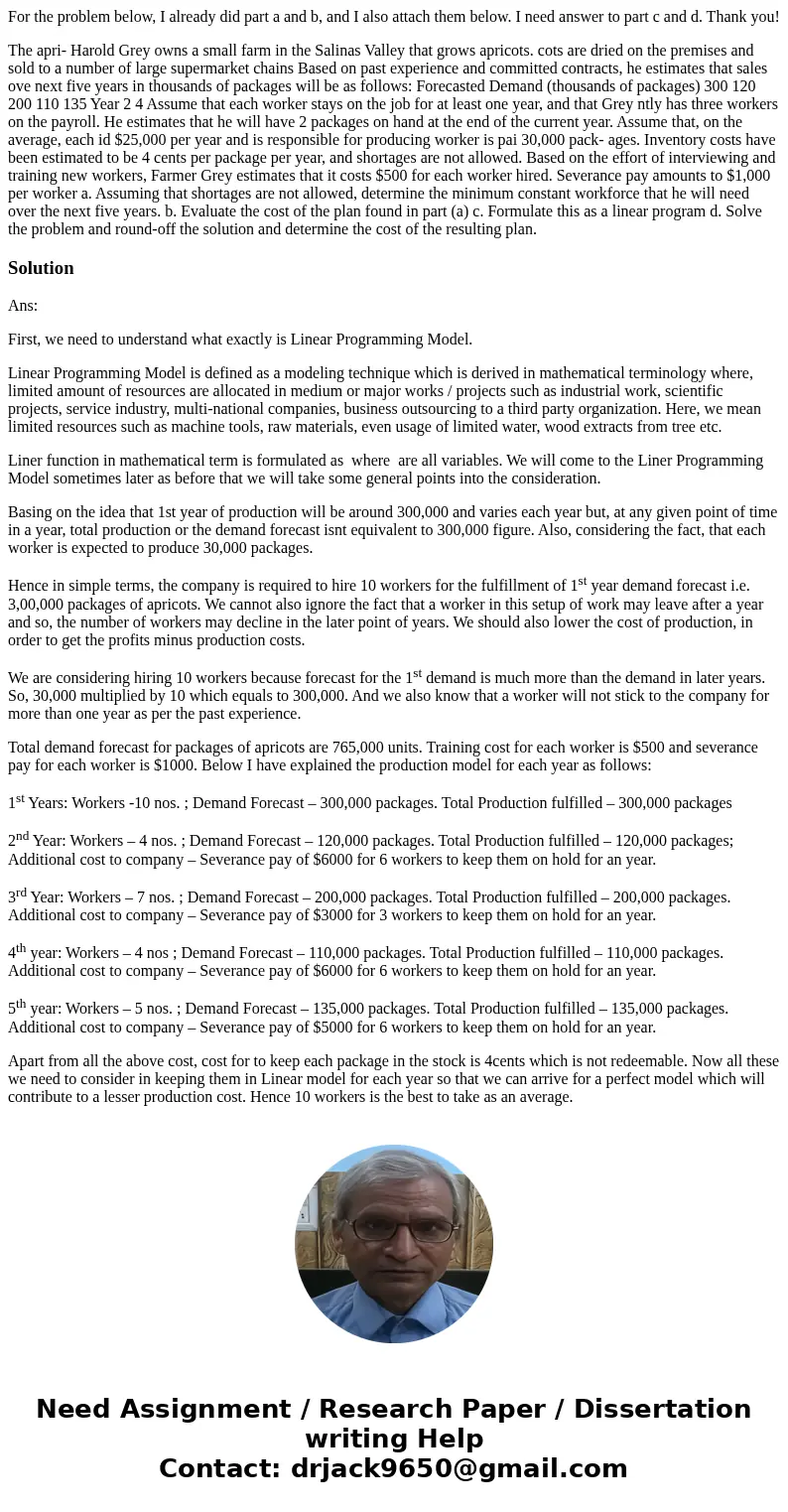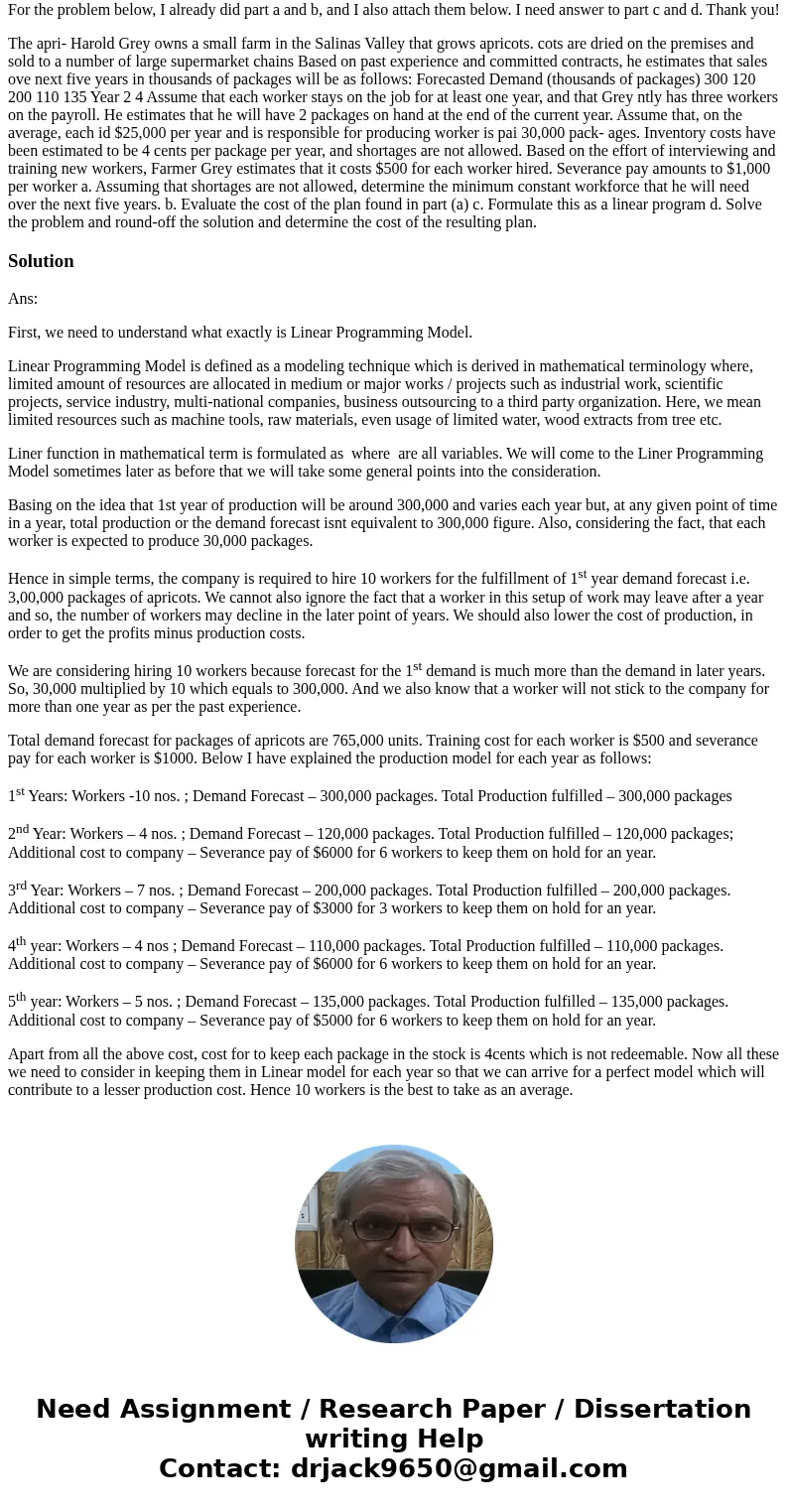For the problem below I already did part a and b and I also
For the problem below, I already did part a and b, and I also attach them below. I need answer to part c and d. Thank you!
The apri- Harold Grey owns a small farm in the Salinas Valley that grows apricots. cots are dried on the premises and sold to a number of large supermarket chains Based on past experience and committed contracts, he estimates that sales ove next five years in thousands of packages will be as follows: Forecasted Demand (thousands of packages) 300 120 200 110 135 Year 2 4 Assume that each worker stays on the job for at least one year, and that Grey ntly has three workers on the payroll. He estimates that he will have 2 packages on hand at the end of the current year. Assume that, on the average, each id $25,000 per year and is responsible for producing worker is pai 30,000 pack- ages. Inventory costs have been estimated to be 4 cents per package per year, and shortages are not allowed. Based on the effort of interviewing and training new workers, Farmer Grey estimates that it costs $500 for each worker hired. Severance pay amounts to $1,000 per worker a. Assuming that shortages are not allowed, determine the minimum constant workforce that he will need over the next five years. b. Evaluate the cost of the plan found in part (a) c. Formulate this as a linear program d. Solve the problem and round-off the solution and determine the cost of the resulting plan.Solution
Ans:
First, we need to understand what exactly is Linear Programming Model.
Linear Programming Model is defined as a modeling technique which is derived in mathematical terminology where, limited amount of resources are allocated in medium or major works / projects such as industrial work, scientific projects, service industry, multi-national companies, business outsourcing to a third party organization. Here, we mean limited resources such as machine tools, raw materials, even usage of limited water, wood extracts from tree etc.
Liner function in mathematical term is formulated as where are all variables. We will come to the Liner Programming Model sometimes later as before that we will take some general points into the consideration.
Basing on the idea that 1st year of production will be around 300,000 and varies each year but, at any given point of time in a year, total production or the demand forecast isnt equivalent to 300,000 figure. Also, considering the fact, that each worker is expected to produce 30,000 packages.
Hence in simple terms, the company is required to hire 10 workers for the fulfillment of 1st year demand forecast i.e. 3,00,000 packages of apricots. We cannot also ignore the fact that a worker in this setup of work may leave after a year and so, the number of workers may decline in the later point of years. We should also lower the cost of production, in order to get the profits minus production costs.
We are considering hiring 10 workers because forecast for the 1st demand is much more than the demand in later years. So, 30,000 multiplied by 10 which equals to 300,000. And we also know that a worker will not stick to the company for more than one year as per the past experience.
Total demand forecast for packages of apricots are 765,000 units. Training cost for each worker is $500 and severance pay for each worker is $1000. Below I have explained the production model for each year as follows:
1st Years: Workers -10 nos. ; Demand Forecast – 300,000 packages. Total Production fulfilled – 300,000 packages
2nd Year: Workers – 4 nos. ; Demand Forecast – 120,000 packages. Total Production fulfilled – 120,000 packages; Additional cost to company – Severance pay of $6000 for 6 workers to keep them on hold for an year.
3rd Year: Workers – 7 nos. ; Demand Forecast – 200,000 packages. Total Production fulfilled – 200,000 packages. Additional cost to company – Severance pay of $3000 for 3 workers to keep them on hold for an year.
4th year: Workers – 4 nos ; Demand Forecast – 110,000 packages. Total Production fulfilled – 110,000 packages. Additional cost to company – Severance pay of $6000 for 6 workers to keep them on hold for an year.
5th year: Workers – 5 nos. ; Demand Forecast – 135,000 packages. Total Production fulfilled – 135,000 packages. Additional cost to company – Severance pay of $5000 for 6 workers to keep them on hold for an year.
Apart from all the above cost, cost for to keep each package in the stock is 4cents which is not redeemable. Now all these we need to consider in keeping them in Linear model for each year so that we can arrive for a perfect model which will contribute to a lesser production cost. Hence 10 workers is the best to take as an average.


 Homework Sourse
Homework Sourse